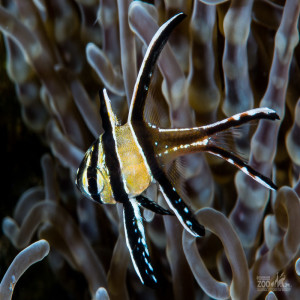 Banggai Cardinalfish are 3 inches in length. It is identified by the tasseled first dorsal fin and elongated anal and second dorsal fin. They are popular in the aquarium trade and now considered endangered. The species has a short life span, reaching around 4 years in captivity and only 1-2 years in the wild.
Banggai Cardinalfish are 3 inches in length. It is identified by the tasseled first dorsal fin and elongated anal and second dorsal fin. They are popular in the aquarium trade and now considered endangered. The species has a short life span, reaching around 4 years in captivity and only 1-2 years in the wild.
Location: Animals Formerly at Zoo
Share:
Range
Banggai Islands of Indonesia, Indonesia, and there are also a small population off Central Sulawesi and the Lembeh Strait.
Habitat
Isolated populations are found concentrated in the shallows of the islands within the Banggai Archipelago. They form groups of about 9 fish in shallow water, which include coral reefs, seagrass beds, and open areas of sand and rubble. They are associated with long spined sea urchins (Diadema setosum) and will hide among them when threatened.
Conservation Status
Endangered
Primary Threats
Overfishing, agricultural and forestry effluents, shipping lanes, pollution
Gestation
Eggs are about 2.5 millimeters in diameter. The male broods the eggs in his mouth for up to 20 days, during which he does not feed. The young remain in the male’s mouth cavity for another 10 days after hatching.
Litter
There is an average of 90 eggs in the clutch.
Behavior
Individual fish have well-defined homing behavior and return to their original location if their group is disturbed.
Reproduction
Males have a large conspicuous oral cavity, different from the female and only noted during brooding. Banggai cardinalfish are paternal mouthbrooders. The female is active in the courtship role and pair formation. Mating pairs have established spawning territories which they defend jointly. Mating occurs over a few hours to a few days. The female stays with the male and aggressively defends him during the time he is holding the eggs and newly hatched young. The females can reproduce once a month, whereas males’ mouth-brood up to six clutches per year.
Wild Diet
Banggai cardinalfish are opportunistic feeders. The diet includes planktonic, demersal, and benthic organisms. Copepods constitute the bulk of their diet.
Zoo Diet

